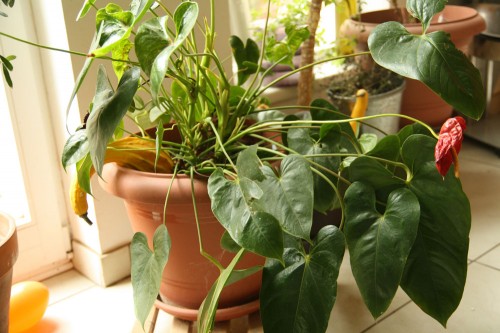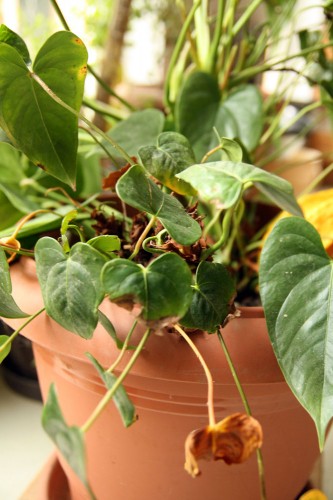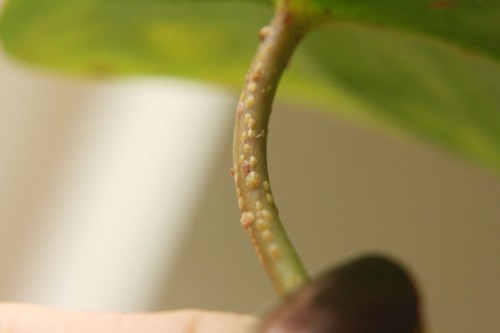Over the last 6 or 7 years, we have collected quite a collection of houseplants. Some of them have fared really well, and others I killed pretty quickly (like every beautiful orchid ever brought into our home).It’s not that I intended for the plants to die; I just wasn’t very good at paying attention to them, giving them water regularly or diagnosing any problems they might develop. Thankfully, I’ve gotten a lot better about all those things!
When we moved into our last rental house in 2004, our friends who were moving back to the states had quite a few houseplants. And needless to say, they couldn’t take them with them. So we inherited a ficus tree (which sadly died a few years later) and an anthurium.
In case you’re not sure what an anthurium is (also sometimes called a Flamingo Flower or Boy Flower because of the way their wax-like flowers look). Here’s one of mine:

Now as luck would have it, we got a second one of these a couple of years ago as a gift. I think they’re pretty cool and was thrilled that we were getting a new one because our old one was looking pretty sickly. You see, our olive tree (which I usually keep indoors and don’t even get me started on how much that thing annoys me) developed scales several years ago. I asked a friend of ours who went to floral school what these wretched little brown bumps on my plants were and how to get rid of them. So she explained the story of “scales” to me.

You see, scales literally suck the life out of your plants. These brown bumps are actually insects which attach themselves to your plants and are completely immobile. More often then not, there will be sticky residue on the leaves around these critters. In the case of our olive oil tree which was rather badly affected, the residue was on the nearby window and all over the floor too. You’ll also notice that your plant just doesn’t seem to be making any progress. It probably won’t die, but it just doesn’t get any bigger, a lot of the leaves will be pale or discolored and a lot of the blossoms will also die off quickly. So what you’re left with is a plant that looks like the one below (which is my older plant — at least 7 years old) instead of the one above.

As you might notice, one leaf on the (mostly) healthy plant is the size of the whole sick plant. And the old one used to be much larger…but when the stems look like this, it really doesn’t stand much chance. These lighter scales are the newer bugs that are just latching on.

At any rate, the important question now is, “How the heck do you get rid of these little suckers?” The following directions will work on just about any sort of houseplant.
One of the smartest things to do is to isolate the sick plant from the rest of your plants. Otherwise it will spread to everything else. Believe me, I know.
Then what you need to do is scrape those little scales off the plant. They are oddly moist which is a bit unpleasant when you do this. But have a paper towel handy and just try not to be too squeamish about it. You can also use the paper towel to scrape them, but you may miss a few. Try to get all of the scales off that you can find. Be sure to check the underside of the leaves and new growth as well to make sure they aren’t staking their claim early. If leaves are dead, go ahead and remove them.
Now what you want to do is keep the scales from coming back. One suggestion I’ve seen (and tried with awesome results) is applying a bit of rubbing alcohol to a cotton pad and rubbing it all over the stems and on the underside of the leaves. You’ve got to be a bit careful about doing this and probably want to try out a stem or leaf first before you do the whole plant because it could hurt/kill the plant.
You can also spray your plants with insecticidal soap (but never use that on ferns) — something I’ve never bought in my life otherwise I may have tried this first. After a week, rinse it off. The easiest way to do that is in the bathtub, which will also help clean your leaves.
If you’ve still got a scale problem after that, wipe the leaf undersides with a solution of 1 tablespoon vegetable oil in 3/4 cup warm water.
Hopefully after that, the scales will go plague someone else — or just die! But honestly, they will hang around forever if you don’t do something about them, continuing to come back time and time again. And your plants will just get more and more sad looking in the process. 😉
Have you ever had scales on your plants? Or is there another pest which plagues your plants instead?
Want to join in the garden fun and link to your own blog or images online? You can share about anything related to gardening, old or new posts, from recipes to harvesting to grow reports to DIY projects or inspiration.
Here’s how this works:
PLEASE READ THESE GUIDELINES, especially if you have never linked up before!
|
That’s it! Share your garden with us by linking up below!




Hi. Discovered your blog! I must tell you that iam finding it to be very interesting! Iam beginning my attempt to live a more sustainable lifestyle and homestead. Hoping to learn a lot from seasoned homesteaders. Would love to connect with yoy nd your friends for your opinions, thoughts and knowledge @http://wwe.mommiesandbeyond.com
Nice post. U do not have any house plants yet but soon!
I don’t have scales on my flamingo , but have these little tiny pin head size bugs crawling around on the dirt, little bumps all over the leaves- not the branches. I used dove soap diluted in lots water, dried it out completely, still there….ugh help
Very useful article!!! I was able to get rid of all these plagues!!! Thank you